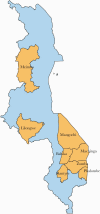HIV Testing Approaches to Optimize Prevention and Treatment for Key and Priority Populations in Malawi
- PMID: 35265725
- PMCID: PMC8900928
- DOI: 10.1093/ofid/ofac038
HIV Testing Approaches to Optimize Prevention and Treatment for Key and Priority Populations in Malawi
Abstract
Background: Despite progress in improving antiretroviral therapy (ART) for people with HIV in Malawi, the burden of HIV infections and HIV treatment outcomes among key populations is suboptimal. Client-centered differentiated service delivery approaches may facilitate addressing HIV prevention and treatment needs of key populations in Malawi.
Methods: De-identified program data routinely collected as part of the LINKAGES project-Malawi were assembled from October 2017 to September 2019. HIV case finding was compared across different testing modalities for each population. Poisson regression was used to estimate the association between testing modalities and ART initiation.
Results: Of the 18 397 people included in analyses, 10 627 (58%) were female sex workers (FSWs), 2219 (12%) were men who have sex with men (MSM), and 4970 (27%) were clients of FSWs. HIV case finding varied by modality and population, with index testing and enhanced peer outreach demonstrating high yield despite reaching relatively few individuals. FSWs who tested positive through risk network referral testing were more likely to initiate ART within 30 days compared with those who tested positive through clinic-based testing (adjusted risk ratio [aRR], 1.50; 95% CI, 1.23-1.82). For MSM, index testing (aRR, 1.45; 95% CI, 1.06-2.00) and testing through a drop-in center (aRR, 1.82; 95% CI, 1.19-2.78) were associated with 30-day ART initiation.
Conclusions: These data suggest that differentiated HIV testing and outreach approaches tailored to the needs of different key populations may facilitate improved ART initiation in Malawi. Achieving 0 new infections by 2030 suggests the need to adapt treatment strategies given individual and structural barriers to treatment for key populations with HIV in high-prevalence settings.
Keywords: HIV testing; Malawi; antiretroviral therapy; female sex worker; sexual and gender minorities; vulnerable populations.
© The Author(s) 2022. Published by Oxford University Press on behalf of Infectious Diseases Society of America.
Figures


Similar articles
-
Increasing Testing Options for Key Populations in Burundi Through Peer-Assisted HIV Self-Testing: Descriptive Analysis of Routine Programmatic Data.JMIR Public Health Surveill. 2021 Sep 30;7(9):e24272. doi: 10.2196/24272. JMIR Public Health Surveill. 2021. PMID: 34591018 Free PMC article.
-
Characterising unmet HIV prevention and treatment needs among young female sex workers and young men who have sex with men in Cameroon: a cross-sectional analysis.Lancet Child Adolesc Health. 2019 Jul;3(7):482-491. doi: 10.1016/S2352-4642(19)30123-3. Epub 2019 May 16. Lancet Child Adolesc Health. 2019. PMID: 31105052
-
Communication needs for improved uptake of PrEP and HIVST services among key populations in Nigeria: a mixed-method study.AIDS Res Ther. 2021 Nov 20;18(1):88. doi: 10.1186/s12981-021-00411-6. AIDS Res Ther. 2021. PMID: 34801037 Free PMC article.
-
Using Digital Communication Technology to Increase HIV Testing Among Men Who Have Sex With Men and Transgender Women: Systematic Review and Meta-Analysis.J Med Internet Res. 2020 Jul 28;22(7):e14230. doi: 10.2196/14230. J Med Internet Res. 2020. PMID: 32720902 Free PMC article.
-
Protecting HIV service delivery for key populations in southern Africa in the context of the COVID-19 pandemic.IJID Reg. 2022 Jun;3:114-116. doi: 10.1016/j.ijregi.2022.03.008. Epub 2022 Mar 16. IJID Reg. 2022. PMID: 35720139 Free PMC article. Review.
Cited by
-
Characterizing HIV Acquisition Risk, Treatment Gaps, and Populations Reached Through Venue-Based Outreach and Clinical Services in Blantyre, Malawi: Findings From a District-wide CLOVE Study.J Acquir Immune Defic Syndr. 2024 Dec 1;97(4):315-324. doi: 10.1097/QAI.0000000000003493. J Acquir Immune Defic Syndr. 2024. PMID: 39020465 Free PMC article.
-
Leveraging Routinely Collected Program Data to Inform Extrapolated Size Estimates for Key Populations in Namibia: Small Area Estimation Study.JMIR Public Health Surveill. 2024 Apr 4;10:e48963. doi: 10.2196/48963. JMIR Public Health Surveill. 2024. PMID: 38573760 Free PMC article.
-
Strengthening implementation guidelines for HIV service delivery: Considerations for future evidence generation and synthesis.PLoS Med. 2023 Mar 6;20(3):e1004168. doi: 10.1371/journal.pmed.1004168. eCollection 2023 Mar. PLoS Med. 2023. PMID: 36877738 Free PMC article.
-
Challenges and Opportunities in Big Data Science to Address Health Inequities and Focus the HIV Response.Curr HIV/AIDS Rep. 2024 Aug;21(4):208-219. doi: 10.1007/s11904-024-00702-3. Epub 2024 Jun 25. Curr HIV/AIDS Rep. 2024. PMID: 38916675 Free PMC article. Review.
-
The future of HIV testing in eastern and southern Africa: Broader scope, targeted services.PLoS Med. 2023 Mar 14;20(3):e1004182. doi: 10.1371/journal.pmed.1004182. eCollection 2023 Mar. PLoS Med. 2023. PMID: 36917570 Free PMC article.
References
-
- UNAIDS. The GAP report. 2014. Available at: https://www.unaids.org/en/resources/documents/2014/20140716_UNAIDS_gap_r.... Accessed 1 February 2021.
-
- Malawi National AIDS Commission. Government of Malawi Malawi AIDS Response Progress Report 2015. 2015. Available at: https://www.unaids.org/sites/default/files/country/documents/MWI_narrati.... Accessed 1 February 2021.
-
- UNAIDS. 90-90-90: an ambitious treatment target to help end the AIDS epidemic. 2020. Available at: https://www.unaids.org/en/resources/documents/2017/90-90-90. Accessed 1 February 2021.
-
- UNAIDS. Malawi. Available at: https://www.unaids.org/en/regionscountries/countries/malawi. Accessed 2 February 2021.
-
- Baral S, Beyrer C, Muessig K, et al. . Burden of HIV among female sex workers in low-income and middle-income countries: a systematic review and meta-analysis. Lancet Infect Dis 2012; 12:538–49. - PubMed

